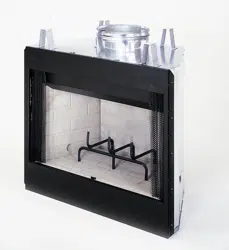Loading ...
Loading ...
Loading ...

SuperiorFireplaces.us.com
126628-01_H
22
APPENDIX A Continued
Smoking – Causes And Troubleshooting
To reduce the likelihood of smoking when opening the door, open
the combustion air control or damper before opening the door.
Your appliance has been designed and tested to provide smoke free
operation. Occasionally, there may be a small amount of smoking
upon lighting the fire, until the chimney heats up but this should not
continue. If the appliance continues to smoke it is probably for one
of the following reasons:
A. Negative pressure in the house -
As the fire burns, air goes up the chimney. This air must be
replaced through leakage into the house or through the outside
air duct. When operating the appliance, open a nearby window
temporarily to check if there is adequate replacement air supply.
B. Blowers operating (e.g.: range hood) - These blowers draw air
out of the house and may actually cause a negative pressure in
the house. Turn off all blowers and open a nearby window to
determine if this is the cause of the problem.
C. Wet wood - Wet or tarred wood will smoulder and smoke instead
of burning properly.
Your dealer can help you determine if you
have properly seasoned wood for burning.
D. Dirty or blocked chimney - Check to make sure the chimney is
clear and clean.
If dirty call a certified chimney sweep or use a
properly sized chimney brush to clean.
E. Chimney not long enough - The minimum chimney height is
twelve (12) feet (3.7 m) not including the appliance height. The
chimney must extend at least three (3) feet (915 mm) above
its point of contact with the roof and at least two (2) feet (610
mm) higher than any roof or wall within ten (10) feet (3 m) of
it. When installed with offsets, the minimum chimney height
is fifteen (15) feet. Additional height will increase draft and will
decrease the tendency to smoke.
F. Poor chimney draft - With no fire, there should be sufficient draft
to exhaust cigarette smoke introduced under the baffle or flue baffle.
Chimneys installed against an outside wall without protection may
generate back draft problems which will cause start-up problems.
To prevent this, open a nearby window, roll up a piece of paper
and light it. Then, hold it in the upper part of the firebox to warm
up the chimney. Wait until the draft is sufficient, then start the fire.
G. Blower for forced air kit operating (some models) - Make
sure that the blower is in the “off” position when you open the
appliance door for reloading.
Locating The Appliance
The best location to install your appliance is determined by consid-
ering the location of windows, doors, and the traffic flow in the room
where the appliance is located, allowing space in front of the unit for
the hearth extension and the mantel, and taking into consideration
the location of the hot air ducts (some models), outside air kit and
chimney.
If possible, you should choose a location where the chimney will pass
through the house without cutting floor or roof joists.
When selecting the location, the chimney outlet position and the
direction of the wind are important factor affecting the chimney per-
formance. To allow a maximum draft and to reduce wind turbulence,
the chimney must:
• Penetrate the highest part of the roof.
• Be installed as far as possible of roof offsets, trees or any other
obstructions that may cause wind turbulence and back drafts in
the chimney.
• The least amount of offsets (elbows) possible. NOTE: A maximum
of 2 offsets is allowed.
4'
4'
8'
Standard
Cord of
Wood
8 Ft.
(2.4M)
4 Ft.
(1.2M)
4 Ft. (1.2M)
Marginal Location
Wind Direction
Location
Not
Recommended
Outside Air
Intake
Facing the Wind
Location
Not
Recommended
Location Recommended
Tree
Figure 1
Figure 2
Prohibited Fuels
These appliances are designed to burn natural well-seasoned wood.
The wood fuel should be air dried seasoned hardwoods, as compared
to softwoods or to green or freshly cut hardwoods. Burning artificial
logs, in some model appliances is allowed (see Installation and Op-
eration manual); please read and follow the instructions provided by
the manufacturer. DO NOT BURN:
NOTE: The use of a firewood moisture meter is recommended
to ensure the firewood contains less than 20% moisture.
Seasoning Guide
Softwoods - 6 months to 18 months
Hardwoods - 12 months to 24 months
Logs that are 5” diameter across or larger should be split in half,
three pieces if over 8 inches, and four pieces when over a foot
across. If a tree has been dead for 2 - 4 years it still needs to be
cut, split, and seasoned for 6 to 24 months depending on the wood.
• Garbage;
• Lawn clippings or yard waste;
• Materials containing rubber,
including tires;
• Materials containing plastic;
• Waste petroleum products,
paints or paint thinners, or
asphalt products;
• Materials containing asbestos;
• Construction or demolition
debris;
• Railroad ties or pres-
sure-treated wood; woods that
have been dipped in tar, pitch,
pine tar, creosote, etc.
• Manure or animal remains;
• Salt water driftwood or
other previously salt water
saturated materials;
• Unseasoned wood;
• Christmas tree branches;
• Paper products, colored
paper, cardboard, plywood,
or particleboard;
• Gasoline;
• Naphtha;
• Engine Oil;
• Flammable Liquids;
• Solvents;
• Grease; or
• Charcoal or Coal
Loading ...
Loading ...
